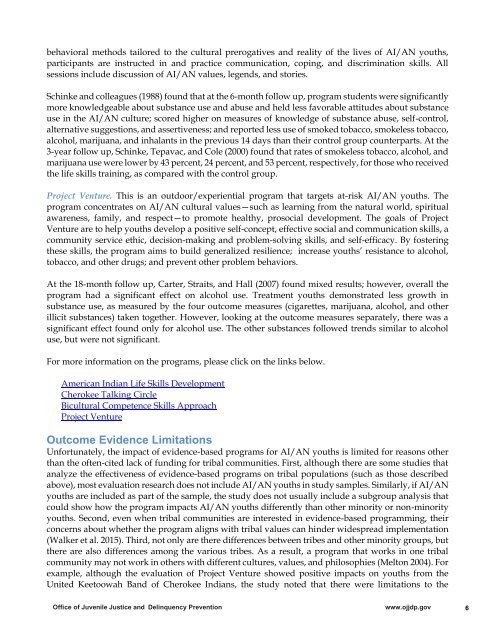Native American Youth In The Juvenile Justice System
Native American Youth In The Juvenile Justice System
Native American Youth In The Juvenile Justice System
Create successful ePaper yourself
Turn your PDF publications into a flip-book with our unique Google optimized e-Paper software.
ehavioral methods tailored to the cultural prerogatives and reality of the lives of AI/AN youths,<br />
participants are instructed in and practice communication, coping, and discrimination skills. All<br />
sessions include discussion of AI/AN values, legends, and stories.<br />
Schinke and colleagues (1988) found that at the 6-month follow up, program students were significantly<br />
more knowledgeable about substance use and abuse and held less favorable attitudes about substance<br />
use in the AI/AN culture; scored higher on measures of knowledge of substance abuse, self-control,<br />
alternative suggestions, and assertiveness; and reported less use of smoked tobacco, smokeless tobacco,<br />
alcohol, marijuana, and inhalants in the previous 14 days than their control group counterparts. At the<br />
3-year follow up, Schinke, Tepavac, and Cole (2000) found that rates of smokeless tobacco, alcohol, and<br />
marijuana use were lower by 43 percent, 24 percent, and 53 percent, respectively, for those who received<br />
the life skills training, as compared with the control group.<br />
Project Venture. This is an outdoor/experiential program that targets at-risk AI/AN youths. <strong>The</strong><br />
program concentrates on AI/AN cultural values—such as learning from the natural world, spiritual<br />
awareness, family, and respect—to promote healthy, prosocial development. <strong>The</strong> goals of Project<br />
Venture are to help youths develop a positive self-concept, effective social and communication skills, a<br />
community service ethic, decision-making and problem-solving skills, and self-efficacy. By fostering<br />
these skills, the program aims to build generalized resilience; increase youths’ resistance to alcohol,<br />
tobacco, and other drugs; and prevent other problem behaviors.<br />
At the 18-month follow up, Carter, Straits, and Hall (2007) found mixed results; however, overall the<br />
program had a significant effect on alcohol use. Treatment youths demonstrated less growth in<br />
substance use, as measured by the four outcome measures (cigarettes, marijuana, alcohol, and other<br />
illicit substances) taken together. However, looking at the outcome measures separately, there was a<br />
significant effect found only for alcohol use. <strong>The</strong> other substances followed trends similar to alcohol<br />
use, but were not significant.<br />
For more information on the programs, please click on the links below.<br />
<strong>American</strong> <strong>In</strong>dian Life Skills Development<br />
Cherokee Talking Circle<br />
Bicultural Competence Skills Approach<br />
Project Venture<br />
Outcome Evidence Limitations<br />
Unfortunately, the impact of evidence-based programs for AI/AN youths is limited for reasons other<br />
than the often-cited lack of funding for tribal communities. First, although there are some studies that<br />
analyze the effectiveness of evidence-based programs on tribal populations (such as those described<br />
above), most evaluation research does not include AI/AN youths in study samples. Similarly, if AI/AN<br />
youths are included as part of the sample, the study does not usually include a subgroup analysis that<br />
could show how the program impacts AI/AN youths differently than other minority or non-minority<br />
youths. Second, even when tribal communities are interested in evidence-based programming, their<br />
concerns about whether the program aligns with tribal values can hinder widespread implementation<br />
(Walker et al. 2015). Third, not only are there differences between tribes and other minority groups, but<br />
there are also differences among the various tribes. As a result, a program that works in one tribal<br />
community may not work in others with different cultures, values, and philosophies (Melton 2004). For<br />
example, although the evaluation of Project Venture showed positive impacts on youths from the<br />
United Keetoowah Band of Cherokee <strong>In</strong>dians, the study noted that there were limitations to the<br />
Office of <strong>Juvenile</strong> <strong>Justice</strong> and Delinquency Prevention www.ojjdp.gov 6

















